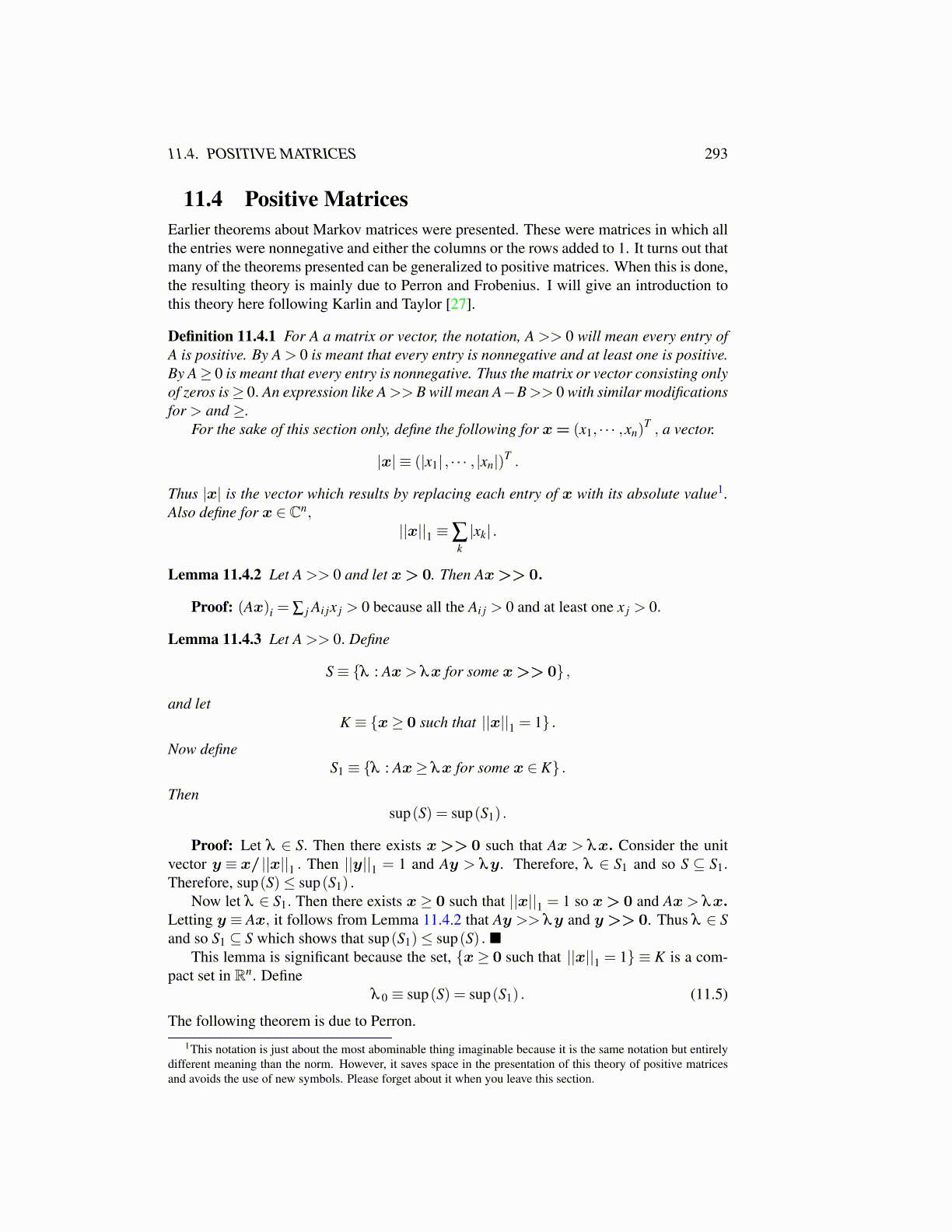
11.4. POSITIVE MATRICES 293
11.4 Positive MatricesEarlier theorems about Markov matrices were presented. These were matrices in which allthe entries were nonnegative and either the columns or the rows added to 1. It turns out thatmany of the theorems presented can be generalized to positive matrices. When this is done,the resulting theory is mainly due to Perron and Frobenius. I will give an introduction tothis theory here following Karlin and Taylor [27].
Definition 11.4.1 For A a matrix or vector, the notation, A >> 0 will mean every entry ofA is positive. By A > 0 is meant that every entry is nonnegative and at least one is positive.By A≥ 0 is meant that every entry is nonnegative. Thus the matrix or vector consisting onlyof zeros is≥ 0. An expression like A>> B will mean A−B>> 0 with similar modificationsfor > and ≥.
For the sake of this section only, define the following for x= (x1, · · · ,xn)T , a vector.
|x| ≡ (|x1| , · · · , |xn|)T .
Thus |x| is the vector which results by replacing each entry of x with its absolute value1.Also define for x ∈ Cn,
||x||1 ≡∑k|xk| .
Lemma 11.4.2 Let A >> 0 and let x> 0. Then Ax>> 0.
Proof: (Ax)i = ∑ j Ai jx j > 0 because all the Ai j > 0 and at least one x j > 0.
Lemma 11.4.3 Let A >> 0. Define
S≡ {λ : Ax> λx for some x>> 0} ,
and letK ≡ {x≥ 0 such that ||x||1 = 1} .
Now defineS1 ≡ {λ : Ax≥ λx for some x ∈ K} .
Thensup(S) = sup(S1) .
Proof: Let λ ∈ S. Then there exists x>> 0 such that Ax > λx. Consider the unitvector y ≡ x/ ||x||1 . Then ||y||1 = 1 and Ay > λy. Therefore, λ ∈ S1 and so S ⊆ S1.Therefore, sup(S)≤ sup(S1) .
Now let λ ∈ S1. Then there exists x ≥ 0 such that ||x||1 = 1 so x> 0 and Ax > λx.Letting y ≡ Ax, it follows from Lemma 11.4.2 that Ay >> λy and y >> 0. Thus λ ∈ Sand so S1 ⊆ S which shows that sup(S1)≤ sup(S) . ■
This lemma is significant because the set, {x≥ 0 such that ||x||1 = 1} ≡ K is a com-pact set in Rn. Define
λ 0 ≡ sup(S) = sup(S1) . (11.5)
The following theorem is due to Perron.1This notation is just about the most abominable thing imaginable because it is the same notation but entirely
different meaning than the norm. However, it saves space in the presentation of this theory of positive matricesand avoids the use of new symbols. Please forget about it when you leave this section.